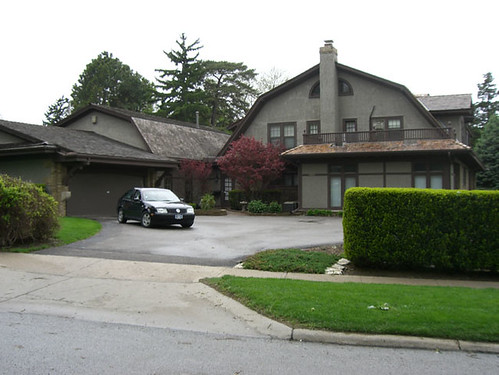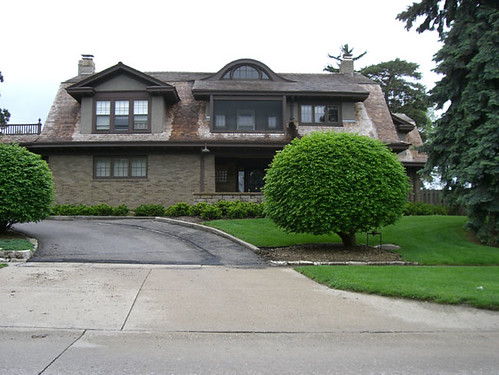

Buffett is born August 30, 1930, in Omaha, Nebraska to Howard and Leila Buffett. Howard, a stock broker, is later elected to Congress.
Buffett has two sisters, Doris and Bertie.
Family history
The Buffetts had already been a business-focused family for generations.
According to The Snowball by Alice Schroeder, the only authorized biography, Warren's grandfather, Ernest, owned a lucrative grocery store; Warren's father started a successful stock brokerage firm amidst the turmoil of the free-falling U.S. economy in 1931.
The family motto is "Spend less than you make," a saying that becomes deeply ingrained in Buffett.
The young hustler
Buffett is a competitive businessman early.
According to The Snowball, he begins selling packs of gum and bottles of Coke at six-years-old to make money, putting the change in his favorite accessory: a nickel-plated money changer attached to his belt.
He also learns about the stock market at his father's brokerage office, where he spends much of his free time.
His favorite book? One Thousand Ways to Make $1,000.
Rebellious phase
At age 14, Buffett files his first tax return, having made $1,000 from his paper route, according to The Snowball.
Although succeeding at business, he is not doing as well in the other areas of adolescent life.
According to the biography, Buffett is rebellious: he and his friends regularly steal from the local department store, and he struggles in middle school for lack of interest.
When his father threatens to take away his source of income, the paper route, Buffett shapes up and starts applying himself.
High School
In 1944, Buffett joins the rest of his family in Washington, D.C., where his father had been elected to Congress. He begins attending Woodrow Wilson High School as a sophomore.
According to Schroeder, "He thought like a businessman but did not look like one.
He fit uncomfortably into the high school crowd, showing up with the same tattered sneakers and droopy socks peeking out from under baggy trousers day after day..."
Understanding that he needs to be liked in order to be more successful, his new favorite book becomes Dale Carnegie's How to Win Friends and Influence People.
Buffett's most lucrative endeavor during high school is a series of pinball machines that he and his friend set up in several barbershops, where they rake in the profits.
University
In 1947, Buffett graduates sixteenth out of 350 students.
Underneath his picture in the school yearbook is the self-awarded title of "future stockbroker," according to The Snowball.
He attends The Wharton School at the University of Pennsylvania that fall, but he is unenthused about undergraduate life.
"What was the point?"
Buffett remembers thinking in the book. "I was making enough money to live on.
College was only going to slow me down."
During his time at Wharton, Buffett pledges Alpha Sigma Phi, the fraternity to which his father and uncles belong as well.
In 1949, after his father loses a Congressional election and returns to Nebraska, Buffett also chooses to go home.
He transfers to the University of Nebraska, where he graduates in 1950 with a B.S. in Economics.
Graduation and marriage
After learning that two of his favorite investers, Benjamin Graham and David Dodd, teach there, Buffett applies to and is accepted by the Graduate School of Business at Columbia.
He graduates with a M.S. in Economics in 1951, and returns to Omaha to work as an investment salesman at his father's firm, Buffett-Falk & Co, according to The Snowball.
In 1953, Buffett marries Susan Thompson, and the next year, they welcome their first child -- Susan Alice Buffett.
Birth of Buffett Associates
In 1954, Buffett accepts a job with his idol, Benjamin Graham, at Graham-Newman Corp. in New York.
That same year, the Buffetts have their second child, Howard Graham Buffett (pictured with sister Susie).
In 1956, Graham decides to retire and offers Buffett the chance to become a general partner.
But according to Schroeder: "Without Ben there, it wasn't worth it to stay, not even to be thought of as Graham's intellectual heir."
He refuses the opportunity and instead returns to Omaha to start his own firm: Buffett Associates, Ltd.
Among the seven total partners, Buffett puts in the smallest share at only $100.
"I was brimming with ideas, but I was not brimming with capital," he remarks in The Snowball.
First partnerships
In 1957, Buffett buys a five-bedroom stucco house in Omaha, according to The Snowball, where he will continue to live through the present.
It costs $31,500 and totals about 6,000 square feet, according to Forbes.
The next year, he welcomes his third child, Peter Andrew Buffett.
Warren is introduced to Charlie Munger in 1959 (pictured), who becomes a close friend and ultimately Vice Chairman of Berkshire Hathaway.
Berkshire Hathaway
In 1962, Buffett is a millionaire for the first time and the Buffett Partnership, which began with $105,000, is worth $7.2 million, according to About.com.
Buffett also begins buying shares in a textile manufacturing firm, Berkshire Hathaway, at the same time as moving the partnership's operations to Kiewit plaza (above), where the company remains.
The minimum investment is raised from $25,000 to $100,000, according to About.com.
In 1967, Buffett is personally worth more than $10 million, according to About.com. He briefly considers leaving investing and pursuing other interests.
Growing success
In 1969, Buffett closes the partnership and liquidates its assets to his partners, according to The Snowball.
His personal stake now stands at $25 million;
he's only 39 years old, according to About.com.
In 1973, Berkshire began to acquire stock in the Washington Post Company, run by Katharine Graham, who becomes a lifelong friend (pictured).
Buffett also invests in other newspapers.
Accumulation of wealth
In 1977, wife Susie and Buffett separate, but remain married.
Warren is introduced to Astrid (pictured) by Susie a year later, who becomes his companion, according to The Snowball.
Professionally Buffett makes the Forbes 400 Richest Americans list for the first time in 1979 with a net worth of $620 million, according to About.com.
Warren continues to live on his annual salary of $50,000.
Cherry Coke
The stock market crashes in 1987, and Berkshire loses 25% of its value, dropping from $4,230 per share to around $3,170, according to About.com.
The day of the crash, Buffett loses $342 million personally.
A long-time fan of Coca-Cola -- especially Cherry Coke -- Buffett began buying its stock in 1988.
It proves to be one of Berkshire Hathaway's most profitable investments.
Buffett eventually purchases up to 7 percent of the company for $1.02 billion, according to About.com.
Lost touch?
Berkshire's stock price goes as high as $80,000 per share in the 1990s.
Still, some wonder if Buffett had "lost his touch" during the dot-com bubble at the end of the decade, according to About.com.
"In 1999, when Berkshire reported a net increase of 0.5% per share, several newspapers ran stories about the demise of the Oracle," says the article.
"Confident that the technology bubble would burst, Warren Buffett continued to do what he did best: allocate capital into great businesses that were selling below intrinsic value."
Diverse holdings
By 2007, Buffett's holding company is well-diversified.
As Forbes notes, there's insurance (Geico, General Re), jewelry (Borsheim's), utilities (MidAmerican Energy), food (Dairy Queen, See's Candies), nearly 80 businesses in total.
Buffett is worth an estimated $62 billion in early 2008.
Gives fortune to charity
In June 2006, Buffett announces he will give away 85 percent of his fortune -- about $37.4 billion at the time -- all in Berkshire stock.
Most of it -- $31 billion -- goes to the Bill & Melinda Gates Foundation, now the largest charitable foundation in the world.
Makes moves in financial crisis
Buffett uses the financial crisis to snap up what he considers undervalued stocks.
In September 2008, Berkshire Hathaway buys $5 billion worth of preferred Goldman Sachs stock and urges investors to "buy American" in a New York Times op-ed.
Buffett also resists some fire-sales, like a last ditch effort from AIG for a loan.
He also was asked to bailout Lehman Brothers, but does not after reviewing the firm's financial reports, according to the Wall Street Journal.
The bets continue
As America pulls out of the recession and the stock market comes back to life, Buffett continues making big bets.
Berkshire Hathaway helps Dow Chemical pay for its takeover of Rohm & Haas with a $3 billion investment in July 2008.
In September 2008, Buffett invests $230 million in BYD, a Chinese electric car company, and seeks to increase the 10% stake less than a year later. In October, he puts $3 billion into General Electric.
Then Berkshire's biggest deal ever. In November 2009, Buffett buys railroad Burlington Northern Santa Fe for $34 billion and bets on the future of the U.S. economy.
Legacy secure
Buffett's legacy is secure.
At 79, he's worth $40 billion, according to Forbes, although that's part of the 85% of his fortune that's been pledged to charity.
He has no plans to retire and is already reaping the profits of his big financial crisis bets, like on Goldman Sachs.
He's remarried to long-time companion Astrid, whom he wed after the death of first-wife Susie in 2004.


